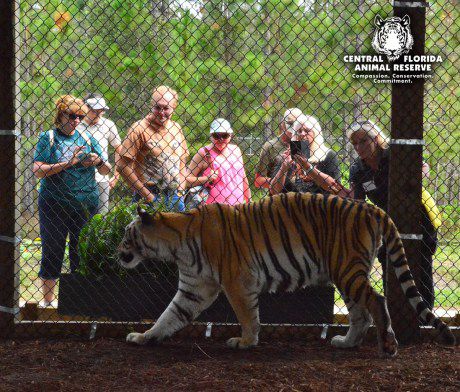HOLOPAW, Fla. (AP) — Gypsy slinked up to a chain link fence to reveal a sleek black coat of fur, fierce canines and heaps of affection for Dr. K. “Simba” Wiltz.
When the 17-year-old Asian leopard arrived at the Central Florida Animal Reserve more than a decade ago, she had severe allergies that had taken a toll on the fur around her face and shoulders. Under the care of the nonprofit’s staff, Gypsy recovered.
Now, the 100-pound feline will be among 22 big cats the public can see on guided tours when the group opens its gates.
“She is a success in the fact that she has chosen to accept us,” said Wiltz, CEO of the reserve. “Even though she was headed for a very different outcome, she now has a beautiful place to hang out and people who really care about her.”
In July, the group moved its tigers, lions, cougars and leopards from a backyard in Cocoa to a permanent location in a corner of Osceola County off U.S. Highway 441 near Forever Florida, about 25 miles south of St. Cloud.
Now, Wiltz is ready to introduce the cats he calls “his kids” to the public.
Visitors to the Central Florida Animal Reserve can go on a walking guided tour of the place. Along the path, they will come within feet of enclosures containing massive Royal White Bengal tigers, Siberian Tigers, lionesses and Gypsy.
“The whole point of the tour is to bring people a lot closer into the world of big cats than they may have ever been before,” Wiltz said.
The hourlong tour costs $25 for adults and $19 for older children only between the ages of 10 and 17. A family tour also is available, which costs $15 for children under 10.
Private and more elaborate tours are also available — including the $300 keeper-for-a-day experience, during which guests help prepare meals of raw meat for the cats, as well as clean their living spaces.
Tours are available on weekends only and must be booked online in advance at http://www.cflar.org.
The guided tours pass by Charger — a curious Bengal tiger that Wiltz calls “The Sentinel” because he always keeps a watchful eye on whoever is on the property — in addition to other large felines quick to greet Wiltz as he shares stories about his cats’ demeanor, diet and background.
Most of his cats had private owners who couldn’t keep up with their expensive diets of 6 to 12 pounds of raw chicken, beef and pork almost daily. Others also need vitamins and medical treatments.
Dr. Tom Blue, a Brevard County dentist who is the president of the reserve’s board of directors, said he received positive reviews from members and donors who went on test tours.
He hopes the tours inspire more to get involved in efforts to protect the cats in the wild.
“You care about what you know about,” Blue said. “They’re having a really difficult time in the wild.”
The World Wildlife Fund reports fewer than 4,000 tigers remain in the wild because of the destruction of habitats and poaching. But the organization states that numbers are on the rise for the first time in a century.
Before it could build the Osceola facility, Central Florida Animal Reserve first had to raise $1.2 million for the 16 wood-frame enclosures designed to withstand strong hurricanes as well as the powerful jungle cats.
When Hurricane Irma battered the region with blustering winds and pounding rains that caused more than $60 million in damage in Osceola County, the 11-acre reserve escaped unscathed.
During the storm, most of the cats curled up in their wooden dens inside their cages that are about 1,000 square feet apiece.
Each enclosure has concrete tubs of water and toys — Kola, a 400-plus-pound lioness, prefers a log, bowling pin and PVC pipe inside of her den.
As the reserve opens to the public, it has its eyes set on further expansion.
The facility has the space to take in more cats, and leaders hope to build an on-site visitor’s center and veterinary center.
“We’re not here as a theme park,” Wiltz said. “We’re here to take care of the cats.”
___
Information from: Orlando Sentinel, http://www.orlandosentinel.com/
www.cflar.org/






